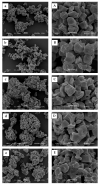Morphology, Mechanical, and Water Barrier Properties of Carboxymethyl Rice Starch Films: Sodium Hydroxide Effect
- PMID: 35056648
- PMCID: PMC8777729
- DOI: 10.3390/molecules27020331
Morphology, Mechanical, and Water Barrier Properties of Carboxymethyl Rice Starch Films: Sodium Hydroxide Effect
Abstract
Carboxymethyl rice starch films were prepared from carboxymethyl rice starch (CMSr) treated with sodium hydroxide (NaOH) at 10-50% w/v. The objective of this research was to determine the effect of NaOH concentrations on morphology, mechanical properties, and water barrier properties of the CMSr films. The degree of substitution (DS) and morphology of native rice starch and CMSr powders were examined. Fourier transform infrared spectroscopy (FT-IR), X-ray diffraction (XRD), and differential scanning calorimetry (DSC) were used to investigate the chemical structure, crystallinity, and thermal properties of the CMSr films. As the NaOH concentrations increased, the DS of CMSr powders increased, which affected the morphology of CMSr powders; a polyhedral shape of the native rice starch was deformed. In addition, the increase in NaOH concentrations of the synthesis of CMSr resulted in an increase in water solubility, elongation at break, and water vapor permeability (WVP) of CMSr films. On the other hand, the water contact angle, melting temperature, and the tensile strength of the CMSr films decreased with increasing NaOH concentrations. However, the tensile strength of the CMSr films was relatively low. Therefore, such a property needs to be improved and the application of the developed films should be investigated in the future work.
Keywords: NaOH; mechanical properties; morphology; solubility; water vapor permeability.
Conflict of interest statement
The authors declare no conflict of interest.
Figures











References
-
- Spychaj T., Wilpiszewska K., Zdanowicz M. Medium and high substituted carboxymethyl starch: Synthesis, characterization and application. Starch-Stärke. 2013;65:22–33. doi: 10.1002/star.201200159. - DOI
-
- Stojanović Ž., Jeremić K., Jovanović S., Lechner M.D. A comparison of some methods for the determination of the degree of substitution of carboxymethyl starch. Starch-Stärke. 2005;57:79–83. doi: 10.1002/star.200400342. - DOI
-
- Li S.F., Mujyambere J.M.V., Liu M. Synthesis of carboxymethyl starch with high degree of substitution by a modified dry process. Adv. Mat. Res. 2011;233:306–310. doi: 10.4028/www.scientific.net/AMR.233-235.306. - DOI
MeSH terms
Substances
LinkOut - more resources
Full Text Sources
Research Materials

